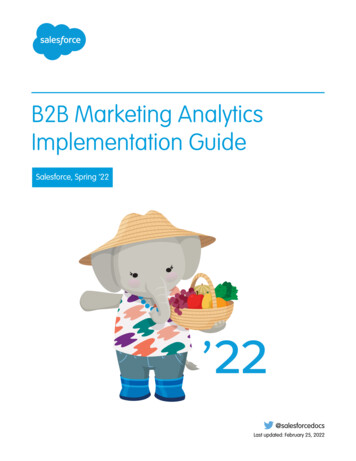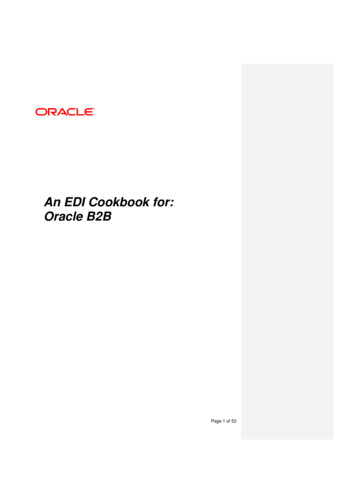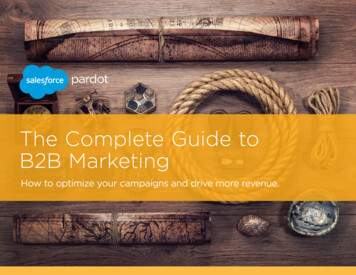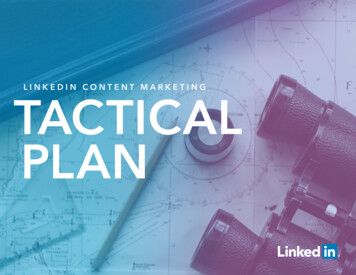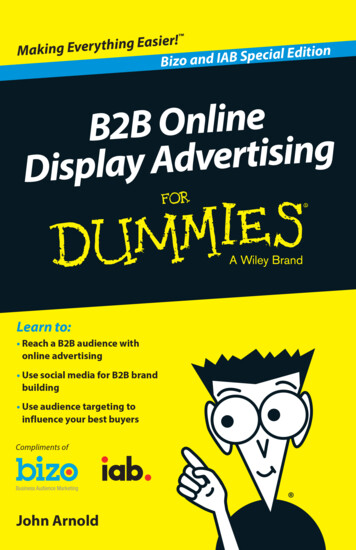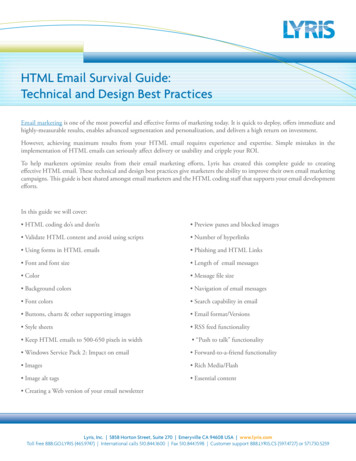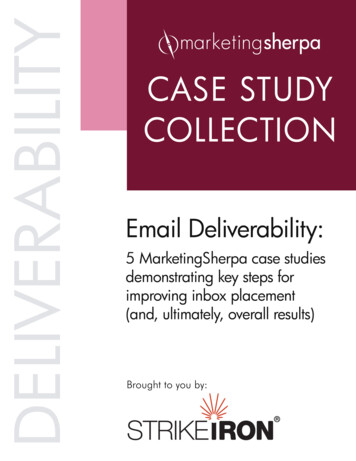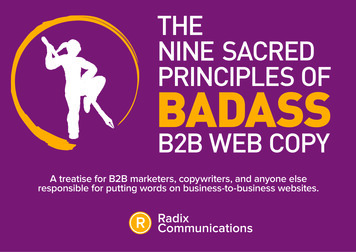
Transcription
A treatise for B2B marketers, copywriters, and anyone elseresponsible for putting words on business-to-business websites.
B2B web copy needs a slap.Life is too short for weak B2B web copy.It’s too short for identikit tones of voice.For text that doesn’t get to the point.(And especially for text that doesn’t have a point.)For “we ought to say something about that” content.For 300 words when 100 will do, “because Google”.For pages that are worthless containers for other pages.For “enough about me; let’s talk about me”.And for having to guess what you’re supposed to do next.
Life’s too short for any of that. Too short to read it and — especially — too short to write it.Right now, in B2B tech, this is what we’re stuck with. But we can change it.You can change it.It takes a choice, and a little commitment. You decide to stop producing weak, aimless webcopy just because someone told you to. You make a stand. You get a bit more badass.And before you type word one, you devote yourself to nine sacred principles.Let us begin.R
Lesson 1: ClarityGet the job done.First things first. Think of some examples of web copy – in fact, any copy at all – that strikeyou as truly badass. What do they have in common?They do the job they set out to do.So. Before you even start writing, work out what that job is. What is this page — thisparticular page — for?Every web page has a purpose in life, or at least it should. In practice, most pages you’ll seedon’t. Presumably, they were written because “we ought to have something aboutthat department” or “we think people care about what we think” but anyway. Give every web page a job, and keep that job in mindwhen you’re writing it, and straight away you’re starting with anadvantage over maybe 95%1 of pages on the internet.195% is a total guess, obviously. It’s not an empirical fact. The point is, more often than you’d think, you’ll find thepage doesn’t have a reason to exist. Worse, people will expect you to write pages like that, too – either becauseit’s what they’re used to, or because a web structure schematic somewhere dictates it. In particular, look out for“branch” pages, which often serve no purpose except to be vaguely themed containers for links to other pages.Life – both yours and your readers’ – is too short to write or read pages like that. Hunt them down, and kill themwithout mercy. The internet will thank you.
For example, in a B2B context, that job might be something like:Attracting people from Google, and giving them usefulinformation, orConvincing people to download an asset, orSelling a product, orReassuring the reader that you know what you’re doing, orPresenting some important facts and figures, orHelping an engineer get their head around the technicalimplications, orEnabling someone to tick a box when they’re shortlistingpotential suppliers, orPrompting the reader to call your sales team.
You’ll note, I said “or”. (Actually, I said it a lot, for effect.) That’s because you need to pickone thing, above all others, that will define whether your page is a success or failure. By allmeans, have some secondary goals, but think about which one you’d like the page to be(whisper it) measured on?Even if you’re not going to be held accountable on the page’s effectiveness, write as if youare. It’ll keep you focused and stop you devoting too much of your energy — and divertingtoo much of the reader’s attention — to things that have nothing to do with what the page isfor.Know what you want to do, WRITE IT AT THE TOP OF THE PAGE2 , and then do it.2For your information only; don’t include it in the actual web copy. That would be confusing.
http://www.radix-communications.comHey! wait a minute What even is a web page anyway?If you’ve been paying attention so far,you might have noticed that I’m referringto “web pages” like they’re one kind ofwriting when actually they’re nothing ofthe sort.Although you do still see the classic 200300 word page of copy, with a heading,standfirst and subheads — maybe somecheeky bullet points thrown in for goodmeasure — it’s by no means the standard.One page of web copy might be almostanything.Often, you’ll be writing a series of panels, ofmaybe 20–100 words, each covering adifferent bit of your subject — and thesecan be almost anywhere in the design.There could be a dozen or more on a reallylong page adding up to hundreds ofwords of copy.The important part is: these principles stillapply — to the page as a whole, and oftento each panel individually. Each part needsto deliver value. To do its job, on its ownterms. To move the reader from where theyare, to where they need to be before thenext part takes over.Treat the page as a page, and — if you’rein any doubt — treat each panel as a page,too.
Lesson 2: FocusOne page at a time.If the first page of copy your reader sees is weak, there are no second chances. There’s awhole internet out there, and the “back” button is one click away. Nobody finding a page ofcrap web copy thinks “maybe the next page will be better”. They’re gone.So assume the page you’re working on right now is the only page in the world.It’s tempting to get distracted if you’re writing more than one page, or even a whole site. Berelentless in your focus.That means setting your stall out. Thinking about where the reader probably came from:did they arrive via the home page, and a bit of abrowse — or did they parachute straight in fromGoogle, without knowing anything about yourcompany at all?Where are they going next?
Break down the purpose of the site, and look at the function of this particular page. Whatare you hoping to change or achieve by the time the reader has moved on to the next one?Now, make sure this one page has everything it needs to achieve that goal.What that probably doesn’t mean:You need to fill the page with enough STUFF to take your reader from knowing absolutelynothing to salivating to buy from you, all in one go. B2B buying usually takes a little while,and several sources of information.What that might well mean:You need to set realistic goals for what one page of web copy can achieve. Selling fromscratch in one page does happen, but it’s rarely a B2B thing. You’re more likely to see it in,say, a landing page for a B2C Google Shopping campaign.One page, to complete one job.
Lesson 3: PerspectiveIt’s not about you.Often, a company’s website structure matches their own organisational structure exactly –with one section or page for each department – regardless of whether or not it makes anysense for someone to find information that way.Assuming your website is about you is a rookie mistake. Your website is about the visitor.It’s the same with the copy on that page you’re writing. You might think it’s about a product,or a service, or a success story but that stuff is only everrelevant so far as it affects your reader3.If the information you’re sharing doesn’t actually make amaterial difference to their world, why on earth are youtelling them? Who else would the page be for?It’s astonishing how much web content exists “just because”. Wholepages of information that nobody will ever want to read, presumablybecause “we ought to have it online”. Be aware of this impulse. Sneakup on it, and beat it to death with a brick.3
So, focus on your reader. Gather up what you know about them. In B2B, this might include:Where they workWhat job they doWhat that means their needs and concerns areWhat they know about your business or sectorWhat context they’re likely to be reading inWith what technologyHow they’re feeling4What language they use.(Go back and read the last two again. They’re important — because they’re the startingpoint for your own language choices.)4Don’t tell me that this is touchy-feely psychobabble, that it doesn’t matter, or that you couldn’t possibly know. I’m talking about how the reader isfeeling in the context of the piece you’re writing. You wouldn’t use the same voice for an apology, error message or legal document as you would foran invitation, confirmation text or needlessly self-important eBook. Not unless you’re a total arse, anyway.
Now — and yes, I’m quite serious aboutthis – print out a picture of that person(or what you imagine they look like). Putit up near your desk. And write to them.That one person. Not a demographic,or a group, or an amorphous, facelesscrowd. One person.Tell that one person what they need toknow on that one page, to achieve yourone job.About “about”Even your “about us” page is notabout you. This is one of the mostread pages on any site, so youneed to make it count — and thatmeans thinking really hard aboutwhat the page is for, and how theinformation you share affects yourreader. (Hint: what the page is foris almost certainly not “just sayingsome stuff about the company”.)
Lesson 4: KindnessSolve the problem.Usually, people go to the internet because they have a problem.Maybe they’re looking for a better way to send invoices. Maybe they need cheaper copierpaper. Maybe they have a deep, dark secret they can’t tell their family, their colleagues,or their doctor. Maybe they want to know your phone number, or your hours of business.Maybe they’re just bored.But when they get to that web page you’re writing, they want something. Your job is to workout what it is, and then give it to them. That’s what makes your content valuable.It’ll also help you to get the best from Google – because one of the reasons why Googleis so popular is that, when you want something, it will usually bring you the page you werelooking for.So write the page your customer is looking for. Easy.
All you need to do now is work out what they’re looking for. This takes a little intuition — butthe beauty of the internet is it’s awash with data, and that data can give away clues if youstare at it long enough:Your own web analytics are a good place to start. Which pages do people arrive at, wheredo they go and — assuming Google sees fit to tell you – which search terms did they use toget there?If you have a search box, it’s always useful to know what people type into it — you get aninstant view of what they want from your site, what they can’t find in the navigation, and thelanguage they use. But most companies never look — many don’t even collect the data.And the usual searchspects are always useful, to give you a broader idea of what peopleare looking for. These days you need to scrape together a picture from a lot of small bits,but try Google’s autocomplete suggestions, Keyword Planner, Google Trends – whateverdata you can get your grubby mitts on will help you build an understanding.Once you have as many clues as you can get, use a bit of intuition to figure out what mightbe motivating that one person to visit that one page, and — whatever else you do — givethem what they came for.
Lesson 5: EmpathyWrite for people. Not Google.Not so long ago, the defining quality of any web page was what Google thought of it. Yoursearch ranking was all that mattered. And so you had to feed Google with keywords andanchor text and all those other morsels it liked5.But Google doesn’t buy your stuff. People do.And as Google has improved its algorithms — its understanding of what a page is about,and what web user wants — things have (thankfully) started to change a bit. So now, there’sa crucial difference.5Imagine Audrey II, but in the form of a very popular search engine. Basically that.
These days, we don’t write for Google; we write for the human beings who use Google.(Specifically, write for the right human beings – the ones for whom that particular pageis relevant and useful. Why would you want to waste your time – and everyone else’s –scaling the heights of the internet to attract a whole bunch of people who’ll never buy fromyou? More of this in lesson 6.)The difference is surprisingly subtle. For instance, if your web page’s job involves attractingsome people from Google You still need to think about keywords — but now, it’s partly because those are the wordsyour visitor is using. You have a direct insight into their own language, and of course itmakes sense to reflect that back to them.Meta data is still important — but now, we need to craft the Title and Description tags sothey stand out on the Search Engine Result Page, and tell a human pair of eyes “pick thisone”. In many cases, they’re the first words a future customer will ever see from your brand,so they need to be chosen with care (not just stuck together by an SEO technician)6.Meta titles work best when SEO and copywriting professionals work together, to arrive at something they’re bothhappy with. At the time of writing, meta descriptions carry no search weight at all, so they’re a pure copywriting job. Gohog wild.6
Think about how you personally use theinternet — and Google in particular. Orimagine you’re the customer. Be realistic,and brutally honest. Once you’vesearched, which link do you pick, andwhy?When the one person you’re writing forsearches for the one thing they needto solve the one problem your pageaddresses, what do you think they wantto see in their search engine results?Write that.Social media users need love tooIf it’s at all likely that the page you’rewriting will be shared on social media,familiarise yourself with the various tagscontrolling what that looks like, becausethat copy might want shaping too. Butbe aware: there are rules to that game(like not using brand names in titles), solook them up first.
Lesson 6: IntegrityNo surprises.When you’ve searched online, and you click through from Google, how long do youwait before deciding whether or not to click “back” and look at the next link down twoseconds? Three?That person you’re writing for.They’ve been tempted by that copy you wrote.The copy describing that exact page.The page they were looking for when they searched.So now, you need to deliver that page.There is absolutely never even the slightest bit of point in trying to trick anybody intocoming to your web page (whether from meta data, an adwords ad, an email, whatever). Itwastes your time, it wastes their time, and they’ll end up hating you a little bit. It is utterlyself-defeating.
But people do it. So when they arrive on your page, they’ll be wary. New web visitors areflighty things: one false move, and you’ll spook them.Your job now is to immediately make them feel at home. Help them to see, straight away,that they are in the right place. This is the place they’re looking for. They can relax, settle in,and have a read.That means your headline — and your standfirst (if you have one — otherwise your first twolines of body copy) absolutely have to deliver.Usually, for a copywriter, that means “don’t try to be clever”. Put the wordplay down (and forGod’s sake back away from the puns) and do the Ronseal thing7.More often than not, you could do a lot worse than making the main page heading theexact same wording as you used in your meta title (or the link on your email, or ad copy, orwhatever brought them here). They liked those words enough to click them, after all.7Say exactly what’s in the tin. Or, in this case, on the page.
Only change that wording if you can improve on it. It’s not laziness; it’s common sense.Likewise, make your first 20 words a concise, clear, compelling version of the entire point ofyour page. No funny business, setting up the body copy. Just get to the point like, imagineyou’re about to die, and you have five seconds to tell them the most important thing. That.Once you’ve done that important bit, and they’ve settled in, then you can be clever (if youabsolutely must).
Lesson 7: ConsistencyAlways add value.Now, think about what you do in the seconds after you’ve decided that maybe this is theweb page for you, after all.You scan down the page, right? Let your eyes flick over the bullet points, subheadings,pictures and captions, get a sense of what’s going on and maybe zoom in on aninteresting bit and have a little read.Only then do you start at the top and read down. Maybe.So in between the five-second version (see lesson 6), and the full, extended p, there’s a level of reading which takes maybethirty seconds or a minute. Your web copy needs to work on that level too.How do you do that? Simple. You make sure every individual part of the page tells thereader something of value — something that helps the page to do achieve the thing youwrote it for.
For example, your page may well have a bullet-pointed list of features. Above this list,perhaps there’s a subhead. On a page that’s less smart than yours, this subhead mightread, not unreasonably, “Features”.Chances are, a reader doing a cursory scan of the page sees that subhead. And when theydo, what sage piece of insight will they learn?There are some features.Not what those features are, what benefits those features have, or what advantages thosefeatures might offer them; purely that some features exist. And they probably could haveguessed that anyway.In short, that heading has attracted their attention, and then squandered it. Zero progresstowards the goal, and zero help for the reader, too.
But you know better, and so your subhead doesn’t say “Features”. Instead of describingthe content below, it summarises or interprets it. Your subheading says what those featuresmean for the reader; what they amount to, or what their effect is.As a nice side-effect, there’s a possibility it now reads as if the subheading is a claim aboutyour product or service, and the features are actually points of proof. There’s a logic to it,and suddenly you’re showing as well as just telling. And that’s always a good thing.Wherever the reader glances on the page, give them something of value. Tell themsomething they didn’t know. Reinforce the main point. Interpret, rather than simply describethe surrounding text.Whether they read the five second version, the full five minutes, or the thirty second glancein between, make sure they get the point — and you get the job done.
Lesson 8: PrescienceKnow what’s next.Like any good agent, a badass web copywriter always knows where the exits are.It’s astonishing how many web pages just stop — with no sense of where the reader mightwant to go next, or how they can take action.So, before you even start writing, know what their next step is — or is likely to be. Writingwithout that information is like getting into a car and simply driving, just because, andseeing where the road takes you (the results are seldom are interesting as you might think).It’s aimless.You’re departing A so know where B is.Importantly, the reader’s next step needs to be natural. It should be somewhere orsomething you could reasonably expect that they might actually want to go or do. As muchas you might wish they’d drop your sales team an email straight away, or register for yourfabulous newsletter, they might have other ideas.
If you can make it that thething they naturally wantto do is the thing you’d likethem to do too, then bingo.Everyone’s happy. But youneed to be realistic aboutjust how possible that is.Also, it’s going to takemore than just a brilliantcall to action button orprompt at the end to makethat next step feel right.It takes all the text on thepage. Which is why you,as the writer, need to keepthat exit point in mind fromthe very first word.8Think about the funnelOf course, there can be more than one possible next step from anypage. Just how many options you give your reader depends on howadvanced they are in their journey.(Weirdly, the buyer’s progression through a website is one areawhere a funnel metaphor actually does work pretty well — arguably,better than in sales and marketing as a whole8 .)At the start, keep things broad. Your reader probably wants lots ofoptions because they’re information gathering — so lots of potentialexits and next steps (e.g. other related blog posts).But as they progressively get into sales-relevant information, you’llwant to slim those options down. If they’re on your contact page (orclose to another desired outcome), this is really not the time to showthem that awesome blog post on Ten Ways Your IT Infrastructure IsLike a Baby Panda.(I don’t care HOW good it is.)As a rule, the funnel metaphor is utter bobbins as a way to describe a sales process. In short: 1. Funnels benefit from gravity. What goesin the top naturally progresses onwards. 2. The sides of a funnel aren’t porous, which would mean you can’t lose any sales. 3. There’s onlyone route through a funnel. Would that it were so simple in B2B sales and marketing.
Lesson 9: PatienceFirst things last.Maria von Trapp didn’t know what she was talking about. The very beginning is a terribleplace to start.Take your web copywriting project. Say it’s a whole site’s worth of copy, more or less.Where do you begin? Just because the home page is the first thing you see on the site9,doesn’t mean it has to be the first thing you write.In fact, it should be the last.9Even this is an old-fashioned, almost pre-Google way of thinking about a website. Like it’s a brochure. You know, a brochure? No? OK,ask your parents. Your grandparents. Maybe they remember seeing one once.
Think about it. Your web page should be the perfect summary of the site – driving homethe one, key message you need to deliver to get the job done. You might also want totempt the visitor with a few, select highlights from your stellar content that are relevant tothe your most important personas.Well, that’s an awful lot easier once that content has actually been written. And likewise,writing an entire site’s worth of content is a great way to really hone the key messages untilthey’re razor-sharp – and ready to sit at the front end of the site, in plain public view.So start with the details. The leaves of the tree. The pages with really small, specific jobs —individual products, services or pieces of information. Then work your way back up alongthe branches — and only then let yourself think about the big, high-profile stuff.It’s the same on each page. You’ll find those all-important first 20 words much easier towrite when you know exactly what they’ll be introducing. And the subheads and captionsthat summarise and interpret their surrounding text so well will all tie in a lot better whenthat text’s already written.
There’s no rule saying where you need to start. So pick somewhere sensible, like A single pageWith a single purposeAnd a clear target audienceWhere you know what they wantAnd can deliver itUsing words they’ll recogniseAll over the pageTo get them to an obvious outcome, that feels natural.Got that? Good.Now begin.
OK, so now what?Well, the flippant thing would be to say “go out and write some badass B2B web copy”. And ifyou feel ready for that, then go ahead. Having read this, you’ve already given it more thoughtthan half the sites out there10.But maybe you don’t feel quite so happy to crack on. That’s OK. There’s a lot to remember.In that case, you have a couple of options:1.We have lots more advice on becoming a completely badass B2B copywriter. Videos, blogposts, a hierarchy of competences, you name it. Have a browse around the Radix blog, maybesign up for the email update. Learn a few things. It can’t hurt.2. You could hire Radix to write the copy for you. We do it all the time, and we’re really verygood (and much more succinct than this ebook would suggest, I promise). Also, becausethere are loads of us, it’ll probably get done quicker. You’ll find our contact details around heresomewhere – but hey: you didn’t download this document to get a sales pitch, so I’ll leave thatthought here.10You must promise to email me a link to the finished product, though. I’m on a mission to rid the world of thoughtless B2B copy, so seeingyour considered pages of properly thought-out text will be a tonic. I hope.
You’ve mastered the sacred principles, and now I charge you with a sacred quest.Go and make the B2B internet a better place.Friendlier.More audience-focused.Easier to read.Between us all, we can make it happen.(Lord knows, it needs to.)R
The nine sacred principles ofBADASS B2B WEB COPY1.Clarity. Get the job done.Decide on the one job your page of web copy absolutely has to achieve. Write it at the top of the page, and then do it.2.Focus. One page at a time.A site is only as good as its weakest page. So act as if the page – or panel – you’re writing is the only one in the world.3.Perspective. It’s not about you.Have a clear idea of who’s reading your page, how they got there, and – most importantly – what they want. Write for them, not you.4.Kindness. Solve the problem.Every web visitor who’s reading your page is there because they need something. Use data to work out what it is, and help them.5.Empathy. Write for people (not Google).Ask yourself why someone would use a particular search term. What page would they most want to see? Write that page.6.Integrity. No surprises.You have about two seconds to show your web visitor they’re on the right page. Deliver on your promises, and do it fast.7.Consistency. Always add value.Wherever your reader looks – every sub-heading, bullet and caption – tell them something helpful and consistent.8.Prescience. Know what’s next.Right from the start, understand where you want your user to go after they’ve finished reading. Make the next step natural.9.Patience. First things last.Start your web project with the detailed stuff, then work backwards to the home page. You’ll know what you’re writing about.
Now go forth, and use your power for good.When you’re ready for more, come to ix-communications.com 44 (0)1326 373592 info@radix-communications.com
You get a bit more badass. And before you type word one, you devote yourself to nine sacred principles. Let us begin. R. Lesson 1: Clarity Get the job done. First things first. Think of some examples of web copy – in fact, any copy at all – that strike you as tr
